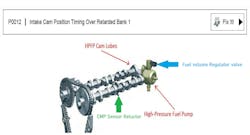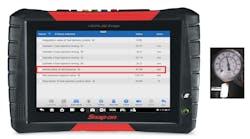Analyzing an underperforming Mazda 6
This one comes from my close friend Brin Kline, owner of Assured Auto Works in Melbourne, Fla. He was faced with a 2006 Mazda 6 2.3L turbo exhibiting poor power output under cruise and acceleration. The vehicle seemed to idle just fine but barely performed, even under low load driving conditions.
Preliminary Analysis
Using his Snap-on Verus Edge scan tool, Brin began his analysis with an all-module DTC scan followed by a careful analysis of pertinent PIDs. DTC P0012 (“Intake cam position timing over retarded”) was present and may offer some insight into the cause of the low-power driveability concern (Figure 1). The P0012 has been present for multiple shop visits but never accompanied by any driveability concern. This approach to driveability faults allowed him to gain insight into the nature of the fault right from the driver’s seat.
One particular PID stood right out (Figure 2). The fuel rail pressure being exhibited by the sensor in the rail is nowhere near the 725-psi commanded during a steady state idle condition. In fact, the pressure in the fuel rail closely mimics that of the low-pressure fuel system feeding the high-pressure fuel pump (HPFP).
This begs the question “why?” The HPFP is a device driven by the camshaft. The specialized cam lobe in this configuration fully strokes the pump’s piston three times per engine cycle. Part of the HPFP is the fuel volume regulator valve (FVR). This device serves as the “trap door.” With the FVR energized and trapping fuel in the pump chamber, the stroking of the piston by the HPFP cam lobes will produce pressure. The earlier in the stroke the trap door is shut, the more pressure is produced from a pump stroke. The later the trap door is shut, the less pressure is produced from a pump stroke.
Some items to consider that affect pump output:
- The low-pressure fuel system (in-tank) must supply the HPFP with fuel.
- The camshaft must stroke the pump properly.
- The FVR must function to trap fuel. Camshaft timing will drastically affect HPFP output.
Observations From the Road Test
Upon conducting an analytical road test, the vehicle seems to idle just fine. Under acceleration, although normal power output cannot be attained, it seems to perform relatively smoothly. More data needs to be gathered but the current state of operation says a lot about the engine’s mechanical condition, considering all the data evident at this time.
Scoping the CKP/CMP for correlation, and comparing it to a known-good example, yields a shift in intake cam timing/retarded (Figure 3). However, retarded intake cam timing would delay the piston stroke and increase pressure output. Solving why the fuel rail pressure matches the low-pressure system is what the primary goal now is and of course, the bullet points listed earlier are what is to be considered. To eliminate a potential circuit issue with the fuel volume regulator valve (the “trap door”), a voltage command/current waveform was obtained and indicated no issue with the performance of the valve or the related circuitry (Figure 4). This leaves only a mechanical fault on the table.
The Data Doesn’t Lie
With all the information in front of us, and the desired information not yet obtained, we are faced with deciding how to proceed. Here are some bullet points of what we know to be factual, and I will ask all of you, diligent readers, for your input:
- Although underpowered, the engine idles and performs smoothly.
- The fuel rail pressure matches the low-pressure system output.
- The low-pressure system produces a sufficient 47 psi of fuel pressure.
- A DTC P0012 is stored.
Given this information, what would you do next?
- Reset camshaft timing and re-evaluate
- Inspect camshaft/pump condition
- Condemn FVR (HPFP assembly)
- Condemn HPFP piston/chamber (HPFP assembly)
About the Author
Brandon Steckler
Technical Editor | Motor Age
Brandon began his career in Northampton County Community College in Bethlehem, Pennsylvania, where he was a student of GM’s Automotive Service Educational program. In 2001, he graduated top of his class and earned the GM Leadership award for his efforts. He later began working as a technician at a Saturn dealership in Reading, Pennsylvania, where he quickly attained Master Technician status. He later transitioned to working with Hondas, where he aggressively worked to attain another Master Technician status.
Always having a passion for a full understanding of system/component functionality, he rapidly earned a reputation for deciphering strange failures at an efficient pace and became known as an information specialist among the staff and peers at the dealership. In search of new challenges, he transitioned away from the dealership and to the independent world, where he specialized in diagnostics and driveability.
Today, he is an instructor with both Carquest Technical Institute and Worldpac Training Institute. Along with beta testing for Automotive Test Solutions, he develops curriculum/submits case studies for educational purposes. Through Steckler Automotive Technical Services, LLC., Brandon also provides telephone and live technical support, as well as private training, for technicians all across the world.
Brandon holds ASE certifications A1-A9 as well as C1 (Service Consultant). He is certified as an Advanced Level Specialist in L1 (Advanced Engine Performance), L2 (Advanced Diesel Engine Performance), L3 (Hybrid/EV Specialist), L4 (ADAS) and xEV-Level 2 (Technician electrical safety).
He contributes weekly to Facebook automotive chat groups, has authored several books and classes, and truly enjoys traveling across the globe to help other technicians attain a level of understanding that will serve them well throughout their careers.




